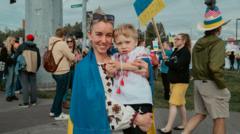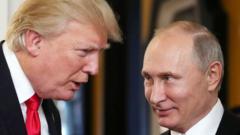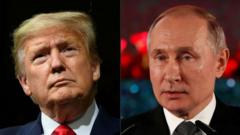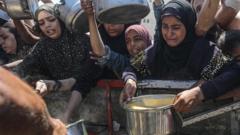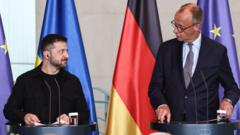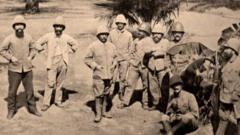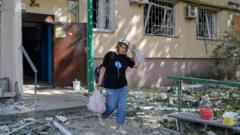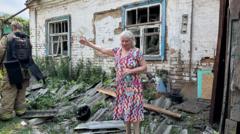A confrontation between Donald Trump and President Cyril Ramaphosa escalated quickly during a White House meeting on Wednesday, revolving around contentious issues related to violence against white farmers in South Africa. Initially light-hearted, the atmosphere shifted dramatically as Trump showcased a video of opposition politicians appearing to encourage violence against white farmers, as well as footage of crosses he claimed represented burial sites for murdered farmers.
Trump's Oval Office Exchange with Ramaphosa: A Review of Claims and Counterclaims

Trump's Oval Office Exchange with Ramaphosa: A Review of Claims and Counterclaims
In a recent White House meeting, Donald Trump confronted South African President Cyril Ramaphosa over alleged violence against white farmers, stirring controversy with disputed statistics and claims.
Supporters of Trump's narrative have long circulated claims of a violent genocide against South Africa's white minority. These assertions were notably amplified during his previous presidential term by figures like Elon Musk and Tucker Carlson. However, many of these claims have been widely criticized and debunked.
One of Trump's key claims involved a video displaying rows of white crosses purportedly marking grave sites for over a thousand murdered white farmers. However, the crosses in the video were actually part of a protest organized in response to the murder of white farmers Glen and Vida Rafferty in 2020, a fact verified by the protest organizer and supported by local media. Furthermore, geolocation analysis confirmed the crosses were no longer present during a Google Street View scan taken in May 2023, demonstrating a disconnect between Trump's assertions and current evidence.
Additionally, Trump's comments regarding "white genocide" were countered by statistics from the South African Police Service. In 2022, there were 26,232 murders overall in South Africa, with only 44 related to the farming community, stressing that claims of a coordinated genocide are unsupported by factual data. A South African court also dismissed the notion of genocide as "imagined" and "not real," indicating a clear divergence between Trump's rhetoric and prevailing legal and statistical analyses.
Trump also focused on supposed anti-white sentiment by playing clips of political rallies where participants sang "Kill the Boer," a controversial anti-apartheid chant. While Trump implied these individuals were government officials, Ramaphosa clarified that the Economic Freedom Fighters (EFF) party, featured in the video, is a minority party and emphasized that government policy does not condone such rhetoric.
Furthermore, the documents Trump presented as evidence of violence against white farmers included an image that was not from South Africa, but from the Democratic Republic of Congo, highlighting a potential misuse of sources to substantiate claims.
This heated exchange has stirred both national and international attention, underscoring the significant discrepancies between Trump's statements and the realities of violence and crime in South Africa.
Overall, the meeting between Trump and Ramaphosa illustrates the complexities and sensitivities surrounding the topic of race and violence in South Africa, with far-reaching implications for bilateral relations and understanding of social issues.
One of Trump's key claims involved a video displaying rows of white crosses purportedly marking grave sites for over a thousand murdered white farmers. However, the crosses in the video were actually part of a protest organized in response to the murder of white farmers Glen and Vida Rafferty in 2020, a fact verified by the protest organizer and supported by local media. Furthermore, geolocation analysis confirmed the crosses were no longer present during a Google Street View scan taken in May 2023, demonstrating a disconnect between Trump's assertions and current evidence.
Additionally, Trump's comments regarding "white genocide" were countered by statistics from the South African Police Service. In 2022, there were 26,232 murders overall in South Africa, with only 44 related to the farming community, stressing that claims of a coordinated genocide are unsupported by factual data. A South African court also dismissed the notion of genocide as "imagined" and "not real," indicating a clear divergence between Trump's rhetoric and prevailing legal and statistical analyses.
Trump also focused on supposed anti-white sentiment by playing clips of political rallies where participants sang "Kill the Boer," a controversial anti-apartheid chant. While Trump implied these individuals were government officials, Ramaphosa clarified that the Economic Freedom Fighters (EFF) party, featured in the video, is a minority party and emphasized that government policy does not condone such rhetoric.
Furthermore, the documents Trump presented as evidence of violence against white farmers included an image that was not from South Africa, but from the Democratic Republic of Congo, highlighting a potential misuse of sources to substantiate claims.
This heated exchange has stirred both national and international attention, underscoring the significant discrepancies between Trump's statements and the realities of violence and crime in South Africa.
Overall, the meeting between Trump and Ramaphosa illustrates the complexities and sensitivities surrounding the topic of race and violence in South Africa, with far-reaching implications for bilateral relations and understanding of social issues.

